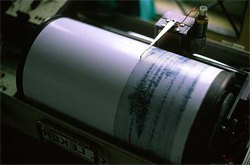 More than 200,000 earthquakes are recorded each year, though it is estimated that several million occur globally. Many of these go undetected because their magnitude is small or they occur in areas which are not closely monitored.
More than 200,000 earthquakes are recorded each year, though it is estimated that several million occur globally. Many of these go undetected because their magnitude is small or they occur in areas which are not closely monitored.
Most seismic events (earthquakes) are very minor, and do not cause any damage – they may not even be felt by the local population. Others cause devastation, much of it due to collapsing buildings.
Can we predict earthquakes?
Earthquake forecasting and prediction is an active topic of geological research. Geoscientists are able to identify particular areas of risk and, if there is sufficient information, to make probabilistic forecasts about the likelihood of earthquakes happening in a specified area over a specified period. These forecasts are based on data gathered through global seismic monitoring networks, high-density local monitoring in known risk areas, and geological field work, as well as from historical records. Forecasts are improved as our theoretical understanding of earthquakes grows, and geological models are tested against observation. Long-term forecasts (years to decades) are currently much more reliable than short to medium-term forecasts (days to months).
It is not currently possible to make deterministic predictions of when and where earthquakes will happen. For this to be possible, it would be necessary to identify a ‘diagnostic precursor’ – a characteristic pattern of seismic activity or some other physical, chemical or biological change, which would indicate a high probability of an earthquake happening in a small window of space and time. So far, the search for diagnostic precursors has been unsuccessful. Most geoscientists do not believe that there is a realistic prospect of accurate prediction in the foreseeable future, and the principal focus of research is on improving the forecasting of earthquakes.
Why are earthquakes difficult to predict?
Most earthquakes result from the sudden release of stress in the earth’s crust, which has built up gradually due to tectonic movement, usually along an existing geological fault. The crust’s response to changing stress is not linear (that is, it is not directly proportional, making prediction of behaviour more difficult), and is dependent on the crust's complex and highly variable geology. As a result, it is very difficult to build accurate simulations which predict tectonic events. Laboratory experiments which attempt to reproduce these physical processes can add to our understanding, but cannot accurately reflect the complexities of real-world geological settings. A further difficulty is that earthquakes originate beneath the ground, often many kilometres down, so data gathering depends on remote observation techniques and measuring effects at the surface. Even measuring the prevailing stress in the crust is challenging, as it requires drilling several kilometres into the ground.
Earthquakes tend to occur as sequences or clusters in close spatial and temporal proximity, but the pattern of these varies greatly. Large earthquakes are sometimes preceded by a series of smaller ones. However, a series of small seismic events does not always prefigure a large one – ‘swarms’ of small earthquakes are common. Patterns of small earthquakes therefore do not provide a diagnostic precursor. (Almost all big earthquakes are followed by smaller ones called aftershocks, and it may be possible to forecast these more accurately.)
Some have suggested that other factors such as increased levels of radon, changes in the water table, variation in the electrical properties of rock or the behaviour of animals may be diagnostic precursors. These have been the subject of research over several decades, and none has been found to be a good indicator, as they can all occur without being followed by an earthquake.
How can earthquake hazard be mitigated?
Evacuation is rarely an effective strategy for mitigating earthquake hazard, because it is not possible to predict the precise timing, location and size of an earthquake to a sufficiently high degree of accuracy. Seismic monitoring and research provide the basis for forecast modelling and hazard assessment and mapping. Geoscientists can provide information about these matters, and can engage with local authorities and communities to ensure that this information is used effectively to minimise risk to people and property. They are likely to undertake this vital work only if their roles and those of others are clearly defined and they feel confident that they can offer geoscientific advice which meets high professional standards without fear of retribution.
The UN identifies the two highest priorities in reducing the effects of earthquakes to be the alleviation of poverty and the development of effective governance. Human habitation is strongly concentrated in seismically active areas, such as at the foot of fault-controlled mountain range-fronts where water may be available in otherwise inhospitable areas. Previously small rural communities have grown into cities or megacities over just a few decades, so the period for which such great concentrations of population have been exposed to high levels of earthquake hazard is very short.
Falling buildings are by far the greatest cause of casualties during earthquakes, so it is essential that new buildings are constructed to withstand their effects. Existing buildings can be retrofitted to withstand earthquakes, but this is much more expensive than doing so at the time of construction. It is also essential that the local population are aware of the risks and know how to act during an earthquake. This can be a particular challenge in areas which are not frequently seismically active, where there may be no memory of large earthquakes.